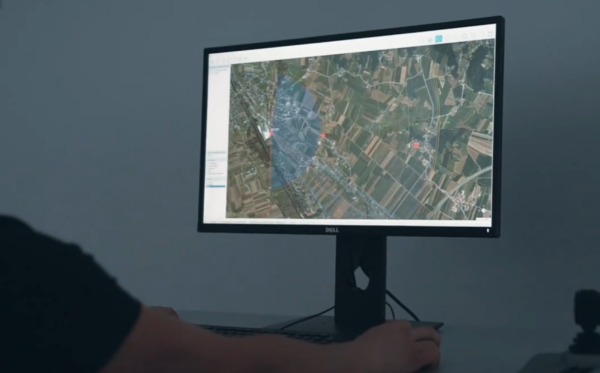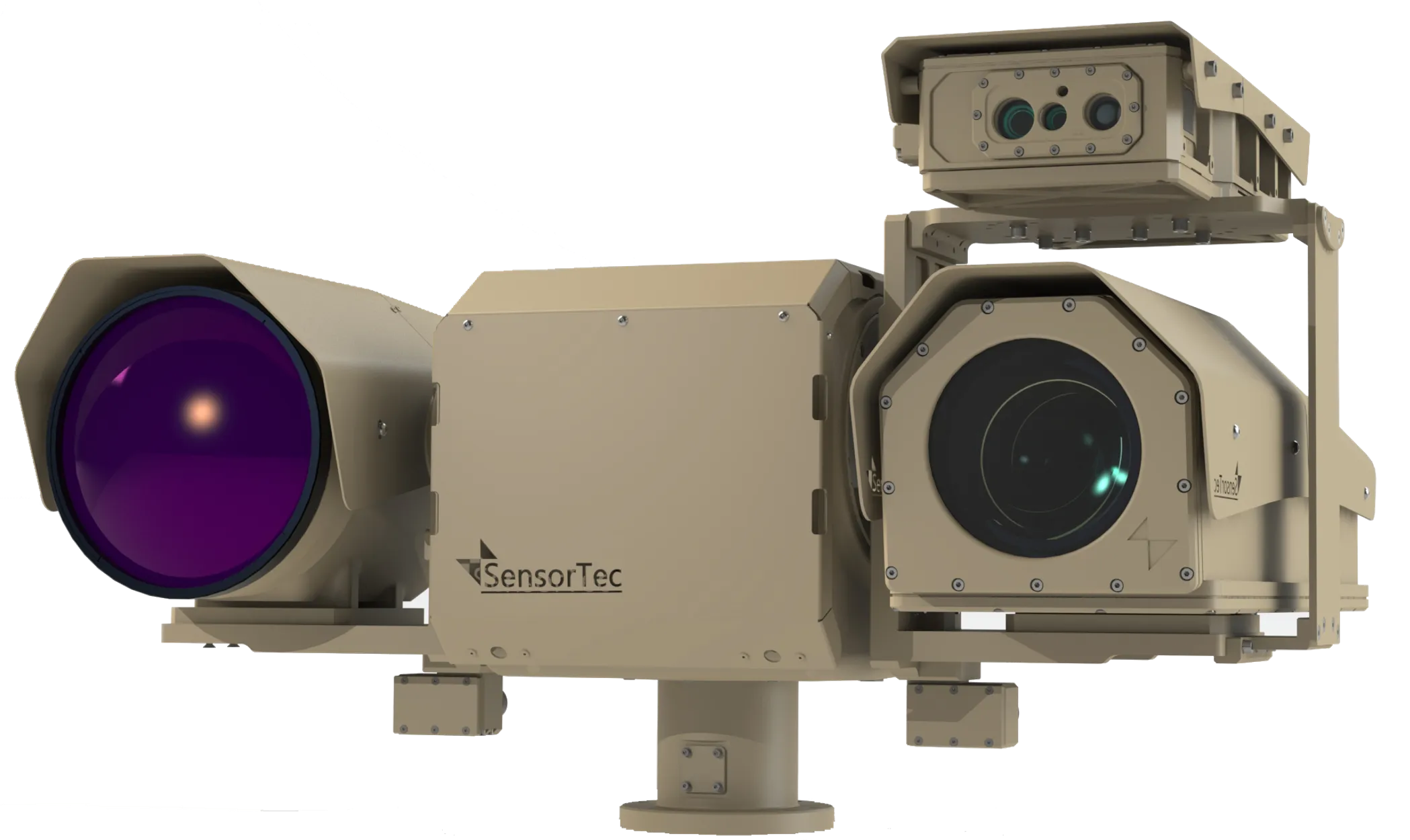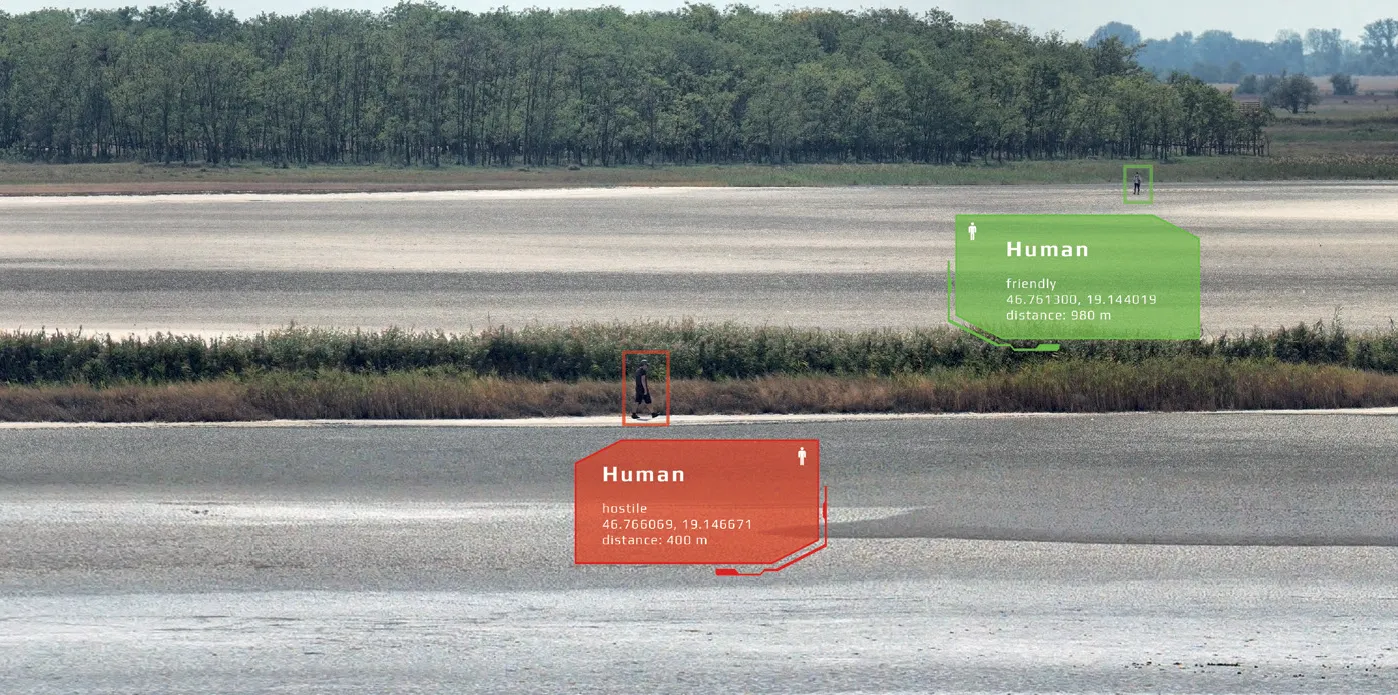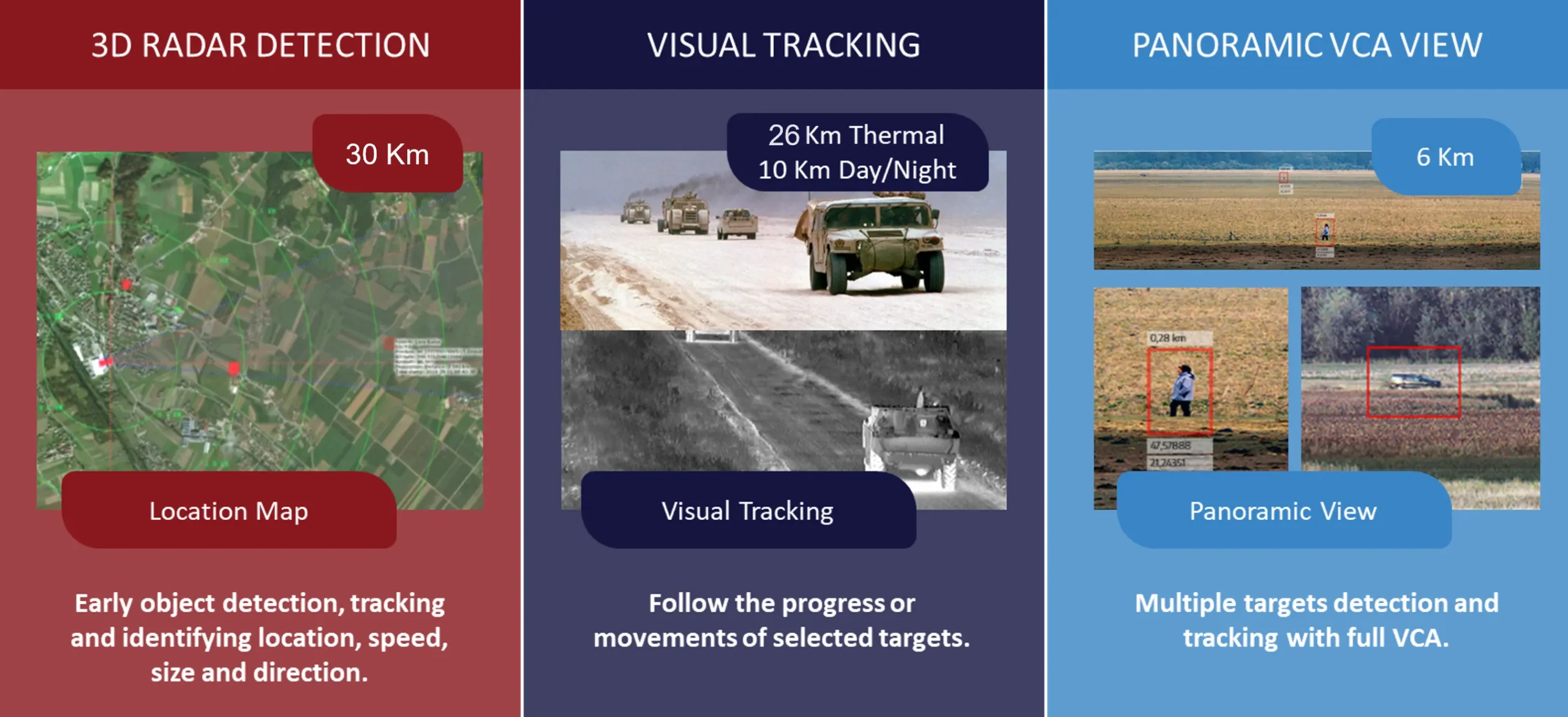
The persistent issue of monitoring vast borders in real-time demands sophisticated technologies and infrastructure. This is why we developed SensorTec Borders Solution. An intelligent video surveillance and security system, comprising various sensors, which operate in fusion and provide high-level of accuracy in automatic target detection, tracking, localization and classification. Leveraging high resolution visible light and thermal sensors, 3D surveillance radars and advanced computer vision technologies. Utilizing sensor fusion technology, our solution is able to realize a comprehensive approach in surveillance, eliminating sensor limitations and producing the lowest false alarm rates.

VISUAL ENHANCEMENT USING
HIGH-END SENSORS
COVERING VAST AREAS
SensorTec borders solutions are designed to fully cover immense border areas even on challenging terrains using high-end surveillance sensors.
The main line of visual coverage consists of our dual-vision panoramic cameras along with multi-sensor PTZ cameras. A single panoramic camera provides 320MP resolution for visible light surveillance and 6MP for thermal vision. It provides 40° FOV and effectively monitors an area of 3.2km² from a single viewpoint. Its resolution allows to detect humans within a range of up to 3km.
Three of these cameras can be installed at a single spot, providing 960MP resolution for visible light surveillance and 18MP for thermal vision. It provides 120° FOV and effectively monitors an area of 9.6km² from a single viewpoint.
MONITORING IN EXTREME RESOLUTION
Displaying 200-960MP panoramic images during live monitoring or archive playback is not an easy task. This amount of data can impose excessive burdens on the network infrastructure and also on client computers.
SensorTec developed a special technology to overcome this issue. The system stores the panoramic images in full resolution on the NVR, but always transmits and displays only relevant pixels. When a panoramic overview is on screen, its horizontal resolution is equal to the screen resolution. When an operator zooms in, the system sends the cropped image in higher resolution. As the zoom value increases, so does the transmitted image resolution.
MULTI-SPECTRAL IR IMAGING
There are many types of imaging technologies available, SensorTec provides multi-sensor systems that allow you to easily take advantage of multiple imaging technologies simultaneously.
AUTOMATIC THREAT DETECTION AND
SITUATIONAL AWARENESS
SensorTec borders solutions offer multifaceted threat detection capabilities to elevate situational awareness. Employing panoramic imaging, long-range thermal imaging, radar, RF signal detection, ground sensors, drones, and other advanced technologies, our solutions ensure round-the-clock vigilance for enhanced day and night situational awareness.
Our design approach focuses on tailoring solutions for optimal performance across short, medium, and ultra-long ranges. This involves seamlessly integrating multiple systems and equipment, spanning from visible light to various infrared spectrum wavelengths, into an integrated solution that provides comprehensive 360° coverage. To further enhance functionality, we incorporate custom AI-powered video content analysis providing AI-powered detection, classification and tracking functions to exceed the limitations of operator-based observation.
PIONEERING TECHNOLOGIES
SensorTec Panoramic Technology

SensorTec Long-Range Multi-Sensor Technology
SensorTec provides a leading-edge fully customized multi-sensor systems employing the longest range visible light day/night zoom cameras and the latest focal plane array technology for cooled or uncooled thermal infrared cameras to meet long-range surveillance and target identification requirements.
SensorTec AI-Powered Video Content Analysis
SensorTec AI-based VCA relies on several advanced method. One of them is the Multidimensional Gaussian Background Model that always adapts to the background and differentiates every moving object from the learnt environment.
The VCA also applies object feature extraction, motion behavior analysis and motion path estimation algorithms in order to realize an intelligent, self-learning virtual environment.
Sensor Fusion Technology
SensorTec developed a specific data level sensor fusion technology, which realizes aggregated raw data analysis for the most accurate automatic detection and tracking possible. The AI algorithm works with uncompressed data that are delivered from different types of data sources. This way our systems are able to overcome the limitations of individual sensors and provide more reliable information of the monitored area and the objects within.
On-Site Recording
SensorTec 4th generation data processing units are available with a special, outdoor design. They are weather and vandal-proof constructions with integrated thermal management to operate on-site. This feature significantly reduces installation costs, as there is no need to deploy fiber optic infrastructure over hundreds of kilometers between the cameras and the control centers.



MAIN FEATURES AND FUNCTIONS
Monitoring
- 200-960MP long range dual vision panoramic video stream.
- Long range multi-sensor monitoring.
- Real-time monitoring in full resolution.
- PTZ control on panoramic images.
- Interactive map.
- Automatic zoom tour.
- Archive video.
AI Video Content Analysis
- Object automatic detection.
- Object automatic tracking.
- Object classification (animal, human, heavy and light vehicle, boat, vessel).
- Multiple target tracking through multiple camera images.
- Tracking path.
- Object speed and direction detection.
- Automatic zoom and tracking function.
- Geofencing.
- Virtual fencing.
Integration
- Long range PTZ cameras.
- Radar systems.
- LASER range finders.
- Positioning systems.
- Seismic sensors.
- Fiber optic sensors.
- 3rd party control software.
FINANCIAL BENEFITS
Reduced Infrastructure Cost
Only few cameras are needed to cover vast areas, as a result no need to install numerous poles. The network infrastructure is far less complex and cabling is also fast and easy.
Long Lifetime
SensorTec leading-edge technologies ensure the system avoids both physical and technological obsolescence for a long time.
Uninterrupted Operation
SensorTec provides uninterrupted system availability as all their components are developed to operate with high MTBF.
Designed To Last
SensorTec systems can withstand intense weather conditions with metal constructions and built-in heating and cooling systems.
No Need For Frequent Maintenance
SensorTec hardware components are capable of self maintenance, thanks to their built-in self-cleaning and deicing systems.
Low Running Cost, Remote Maintenance
Beside standard maintenance, which is well-planned and organized, SensorTec provides remote maintenance as well. The system constantly gives feedback on the condition of the cameras and other components. By exploring early warnings, failures can be prevented.
Less Manpower
As vast areas can be monitored with much fewer cameras that provides far better spatial orientation for viewers and also VCA based Real-time Decision Making Support, far less operators are needed for efficient surveillance.
INTEGRATED SYSTEMS
MTDU
SensorTec employs an integrated system referred to as the Multi-Technology Detection and Tracking Unit (MTDU), which provides the ability to track multiple targets simultaneously. MTDU uses Tracking Radar, Long-range Thermal Camera, Long-range Day/Night Camera, Panoramic Camera to enable the detection, tracking, identification, and classification of illegal border entries.

ANTI-DRONE/COUNTER-UAV
SensorTec offers a compact air defense solution against drones/UAVs that was developed and tested for border protection projects. Radar, long range observation system, radio frequency detector and high power radio frequency jammer are able to detect, recognize, identify and soft/hard kill flying objects.
Our system is built to operate 24/7 continuously and it can be installed as fixed, portable or mobile solution. Integrated 3D radar works with the latest generation solid state technology electronic scanning. Thermal camera gives the system long detection, recognition and identification range.

Planning & Strategy
TURNKEY BORDERS SOLUTIONS
In SensorTec, we aim to refine the borders security experience by providing our clients with an unrivalled range of turnkey solutions for surveillance and security systems, by understanding and building for the many challenges of multifaceted integrations.
VIDEOS












